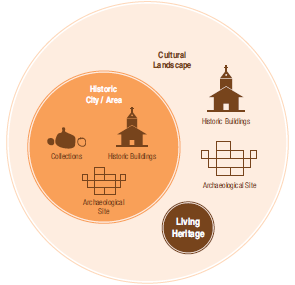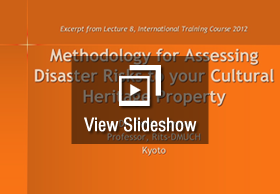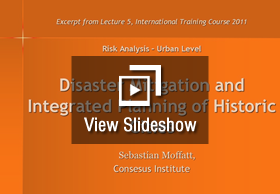


Lectures comprised of secondary case examples, rapid fire slide shows and discussions drawing upon participant experiences may be used to explain the changing scope of heritage especially in an urban context using relevant examples. Key concepts may be supported by personal anecdotes. Some concepts could also be illustrated on a white board or flip chart. Examples which would help the participants relate the theoretical content to actual events or sites should be highlighted. The instructor should facilitate discussion among participants on their understanding of cultural heritage and the challenges of conservation and management.
What is Cultural Heritage?'
An excerpt from Significance of Disaster Risk Management and Core Principles
Lecture 3, International Training Course, 2012
Instructor: Rohit Jigyasu


Disaster Mitigation and Integrated Planning of Historic Cities
Lecture 5, International Training Course 2011
Instructor: Sebastian Moffat


Disaster Mitigation and Integrated Planning of Historic Cities, Lecture 5, International Training Course 2011
Instructor: Sebastian Moffat | Duration: 80-90 minutes
This session summarised three innovations in analysis and urban planning, which form a part of the principles, approaches and methodologies to assist with the analysis of risks and disaster risk management for urban heritage.
These innovations are:
1. Conceptualising the built environment as a socio economic system.
2. Systems thinking and the process of integrated planning and design.
3. Collaborative modes of decision-making and policy formation.
Each of these innovations has generated a series of tools and practices. These were examined one by one, and specific questions about each topic were addressed. The central question of this session was then focused on:
How might this concept/tool/method assist with the preparation and application of disaster risk management plans for cultural heritage in urban environment?
Rapid fire slideshows, diagrammatic explanation of concepts and case studies were used to communicate the content.